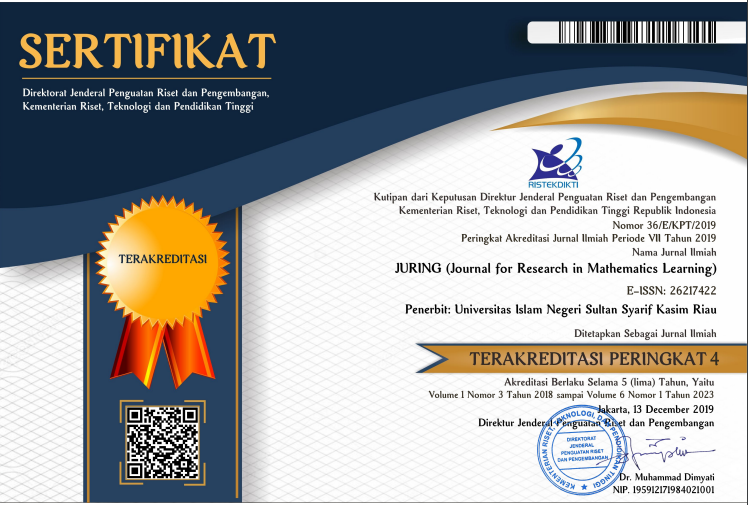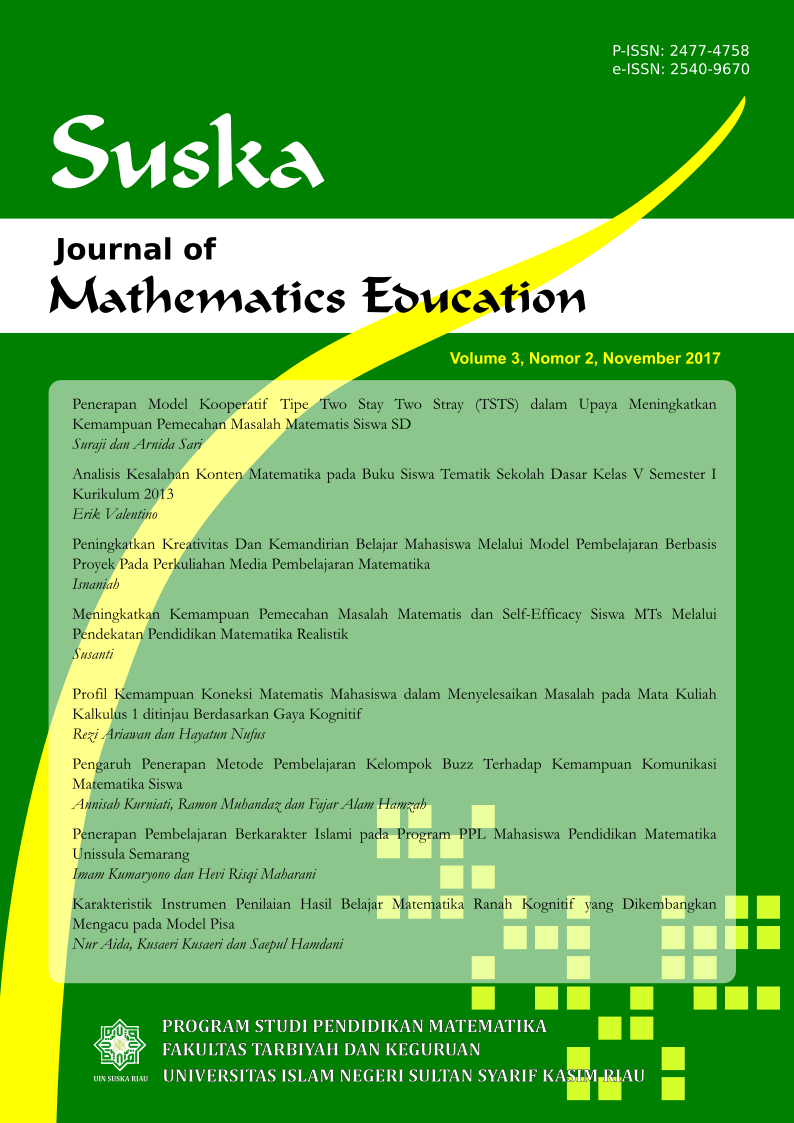Pengembangan Instrumen Literasi Matematis Model PISA dengan Pemodelan Rasch untuk Siswa Sekolah Dasar
Abstract
Penelitian ini bertujuan untuk mengembangkan sebuah instrumen yang digunakan untuk mengukur kemampuan literasi matematis siswa SD. Penelitian ini menggunakan model pengembangan 4D (Define, Design, Develop, and Desseminate) yang dimodifikasi sampai pada tahap Develop saja. Penelitian ini mengambil sampel siswa SD yang tersebar di wilayah Riau yang berjumlah 113 orang dan DKI Jakarta yang berjumlah 176 orang siswa (62,97 % perempuan dan 37,03% laki-laki) ) yang berasal dari 4 SD yang berbeda. Teknik pengumpulan data dalam penelitian ini adalah berupa kuisioner dan tes. Terdapat dua instrumen yang digunakan dalam penelitian ini yaitu lembar validasi soal dengan skala likert dan soal literasi matematis berbentuk pilihan ganda dan essay. Teknik analisis yang digunakan yakni untuk Analisis hasil lembar validasi soal menggunakan indeks V Aiken sedangkan analisis butir soal menggunakan model Rasch. Berdasarkan hasil analisis data , diperoleh bahwa ke-10 soal dinyatakan valid dan reliabel berdasarkan item fit, wright map, person separation index dan fungsi informasi butir. Hasil temuan menunjukkan bahwa instrumen ini dapat secara akurat untuk mengukur kemampuan literasi matematis siswa SD khususnya pada tingkat kemampuan tinggi dan rendah sedangkan unutk kemampuan moderate kurang relevan karena tidak ada butir yang memiliki taraf sukar sedang.
Full Text:
PDFReferences
Andriani, R. (2023). Sikap Ilmiah Siswa Sekolah Menengah Atas (SMA): Pengembangan Instrumen. Jurnal Pendidikan MIPA, 13(1),1-9. https://doi.org/10.37630/jpm.v13i1.787
Arikunto, S. (2010). Metode peneltian. Rineka Cipta.
Bond, T. G., & Fox, C. M. (2015). Applying the Rash Model: Fundamental in the human sciences. Third Edit, 1l.
Christensen, K. B., Makransky, G., & Horton, M. (2017). Critical Values for Yen’s Q3: Identification of Local Dependence in the Rasch Model Using Residual Correlations. Applied Psychological Measurement, 41(3), 178–194. https://doi.org/10.1177/0146621616677520
Debelak, R., & Koler, I. (2019). Debelak, R., & Koller, I. (2019). Testing the Local Independence Assumption of the Rasch Model With Q3-Based Nonparametric Model Tests. Applied Psychological Measurement, 014662161983550. https://doi.org/10.1177/0146621619835501
Dewi, N. L. P. E. S., Pramartha, A. A. G. Y., & Wahyuni, L. G. E. (2024). Pelatihan Penyusunan Asesmen Diagnostik Untuk Guru Bahasa Inggris Sekolah Dasar. Seminar Nasional Pengabdian kepada Masyarakat, 9(1), 1733-1738.
Doran, H. C. (2005). The Information Function for the One-Parameter Logistic Model: Is it Reliability? Educational and Psychological Measurement, 65(5), 665–675. https://doi.org/10.1177/0013164404272500
Fauzi, A. A., Susongko, P., & Hayati, M. N. (2022). Tes Kemampuan Berpikir Kritis pada Pembelajaran IPA di SMP Berbasis Model Rasch. PSEJ (Pancasakti Science Education Journal), 7(1), 59-67. https://doi.org/10.24905/psej.v7i1.146
Fraenkel, J. R., & Wallen, N. E. (2009). How to Design and Evaluate Research in Education (7thEd.). McGraw-Hill Companies.
Geiger, V., Forgasz, H., & Goos, M. (2015). A Critical Orientation to Numeracy across the Curriculum. ZDM: The International Journal on Mathematics Education, 47(4), 611–624. https://doi.org/10.1007/s11858-014-0648-1
Hayati, R., & Yuhana, Y. (2024). Development Of Mathematical Literacy Skill Instruments On Circle Material For Junior High School Students. Journal of Authentic Research on Mathematics Education (JARME), 6(2), 165-174. https://doi.org/10.37058/jarme.v6i2.11635
Heale, R., & Twycross, A. (2015). Validity and reliability in quantitative studies. Evidence-Based Nursing, 18(3), 66–67. https://doi.org/10.1136/eb-2015-102129
Holster, T. A., & Lake, J. (2016). Guessing and the Rasch Model. Language Assessment Quarterly, 13(2), 124–141. https://doi.org/10.1080/15434303.2016.1160096
Indihadi, D., Suryana, D., & Ahmad, A. B. (2022). The analysis of construct validity of Indonesian creativity scale using Rasch model. Creativity Studies, 15(2), 560-576. https://doi.org/10.3846/cs.2022.15182
Kerlinger, F. N., Lee, H. B., & Bhantumnavin, D. (2000). Foundations of behavioral research: The most sustainable popular textbook by Kerlinger & Lee (2000). Journal of Social Development, 13(2), 131–144.
Linacre, J. M. (2002). Optimizing rating scale category effectiveness. Journal of Applied Measurement, 3, 85–106.
Linacre, J. M., & Wright, B. (2000). Winsteps. URL: http://www. Winsteps. Com/index. Htm [accessed 2013-06-27][WebCite Cache].
Lowenthal, K. M. (2001). An Introduction to Psychological Tests and Scales. 2nd ed. Psychology Press.
Mardapi, D. (2008). Teknik Penyusunan Instrumen Tes Dan Non Tes. Mitra Cendekia.
Naga, D. S. (2023). Teori sekor pada pengukuran mental. PT. Ngarani Citrayasa.
NCTM. (2000). Principles and Standards for School Mathematics. The National Council of Teachers of Mathematics, Inc.
Nuryati, N., & Darsinah, D. (2021). Implementasi Teori Perkembangan Kognitif Jean Piaget dalam Pembelajaran Matematika di Sekolah Dasar. Jurnal Papeda: Jurnal Publikasi Pendidikan Dasar, 3(2), 153-162. https://doi.org/10.36232/jurnalpendidikandasar.v3i2.1186
OECD. (2018). PISA 2018 Assessment And Analytical Framework: Mathematics,Reading, Science, Problem Solving And Financial Literacy. OECD Publishing.
Saputra, H. (2024). Perkembangan Berpikir Matematis Pada Anak Usia Sekolah Dasar. Jemari (Jurnal Edukasi Madrasah Ibtidaiyah), 6(2), 53–64. https://doi.org/10.30599/jemari.v6i2.
Sari, R. H. N., & Wijaya, A. (2017). Mathematical literacy of senior high school students in Yogyakarta. Jurnal Riset Pendidikan Matematika, 4(1), . https://doi.org/10.21831/jrpm.v4i1.10649.
Shaumi, F. N., & Syamsuri, S. (2024). Pengembangan Instrumen Literasi Matematis dengan Konteks Kue Tradisional Banten pada Tingkat SMP. Kognitif: Jurnal Riset HOTS Pendidikan Matematika, 4(1), 585-604. https://doi.org/10.51574/kognitif.v4i1.1691
Sitopu, J. W., Khairani, M., Roza, M., Judijanto, L., & Aslan, A. (2024). The Importance Of Integrating Mathematical Literacy In The Primary Education Curriculum: A Literature Review. International Journal of Teaching and Learning, 2(1), 121-134.
Smith Jr., E. V. (2002). Understanding Rasch measurement: Detecting and evaluating the impact of multidimenstionality using item fit statistics and principal component analysis of residuals. Journal of Applied Measurement, 3(2), 205–231.
Suryani, Y. E. (2018). Aplikasi Rasch Model dalam Mengevaluasi Intelligenz Structure Test (IST). Psikohumaniora: Jurnal Penelitian Psikologi, 3(1),73. https://doi.org/10.21580/pjpp.v3i1.2052
Taherdoost, H. (2016). Validity and Reliability of the Research Instrument; How to Test the Validation of a Questionnaire/Survey in a Research. International Journal of Academic Research in Management (IJARM), 5. https://hal.science/hal-02546799
Tennant, A., & Conaghan, P. G. (2007). The Rasch measurement model in rheumatology: What is it and why use it? When should it be applied, and what should one look for in a Rasch paper? Arthritis Care & Research, 57(8), 1358–1362. https://doi.org/10.1002/art.23108
Thiagarajan, S., & Others, A. (1974). Instructional Development for Training Teachers of Exc eptional Children: A Sourcebook. Council for Exceptional Children, 1920 Association Drive, Reston, Virginia 22091 (Single Copy, $5. https://eric.ed.gov/?id=ED090725
Widia, W., Fuadiah, N. F., & Surmilasari, N. (2024). Pengembangan Instrumen Asesmen Berbasis Literasi Numerasi Pada Materi Skala Perbandingan Pada Kelas V SD. Pentagon : Jurnal Matematika Dan Ilmu Pengetahuan Alam, 2(3), 99–107. https://doi.org/10.62383/pentagon.v2i3.232
DOI: http://dx.doi.org/10.24014/juring.v7i4.34020
Refbacks
- There are currently no refbacks.
Juring (Journal for Research in Mathematics Learning)
Universitas Islam Negeri Sultan Syarif Kasim Riau
Indexed by:













